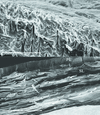issue contents
November 2008 issue

Cover illustration: Schematic of an X-ray reflection interface microscope (see Fenter, Park, Kohli & Zhang, pages 558-571). This microscope images the physical topography (e.g. steps) on a surface through full-field imaging of phase contrast in the X-ray beam reflected from the surface. The images at the bottom illustrate the control of image contrast obtained at an orthoclase (001) surface (left: at the specular reflection condition; right: +0.02° off the specular reflection condition). The image contrast is controlled by changes to the incident angle through the variation of the local interfacial structure factor.
facility information
research papers
Novel internally water-cooled Si monochromators are described which reduce rocking-curve enlargement owing to fabrication to less than 2.5 µrad.
A new scattering technique in grazing-incidence X-ray diffraction geometry is described which enables three-dimensional mapping of reciprocal space by a single rocking scan of the sample.
The mechanism of image contrast in imaging molecular-scale features on solid surfaces is described for X-ray reflection interface microscopy through comparison of experimental images with model calculations and simulated measurements.
The importance of crystallography for XAS analyses and, therefore, the necessity to obtain crystallographic information at high spatial resolution prior to spectroscopic analysis is demonstrated.
Single crystals of the protein ferritin are imaged using coherent X-ray diffraction imaging and the results show the presence of inward surface strain.
This report presents a simple procedure for extracting local reciprocal lattice vectors from the displacements calculated within a crystal under bending or thermal load by the widely used ANSYS® Workbench™ finite-element software.
Protein powder diffraction data can be obtained from submicrometer crystals of the membrane protein photosystem 1 using a flow-focusing liquid microjet for sample delivery.
The high-energy X-ray reflectivity set-up of BL9 at DELTA is presented together with measurements which show the capabilities of the set-up.
Diffraction of partially coherent X-ray waves from clessidra (hourglass) lenses has been theoretically described. The good agreement between theory and experimental data leads to an insight into the operation of clessidra lenses.
Dead-time corrections are presented for different operating modes of a synchrotron. Detector speed and synchrotron fill pattern are critical for determining appropriate dead-time corrections.
By performing inelastic X-ray scattering experiments using a 12-analyzer array, the complete set of single-crystal elastic constants of MgO were determined to a precision better than 0.8% (sound velocities to better than 0.2%).
The main red shift of N1s and C1s core ionization spectra of the purine bases is found with respect to the unsubstituted purine, and is different from the dominated blue shift in the pyrimidine counterparts. The atomic-site-dependent energy-level crossings of the core ionization spectral peaks in adenine, guanine and unsubstituted purine are detailed.
A set-up has recently been developed that combines three X-ray-based techniques, small- and wide-angle X-ray scattering (SAXS/WAXS) and quick-scanning EXAFS (QEXAFS), for the study of dynamical chemical processes.
A satisfactory model was found for EXAFS from iodine in thyroxine; this model was augmented to include quasi-covalent bonding from iodine to carbonyl ligands for rat, human and sheep thyroids. These models will be helpful in estimates of radiation dose to thyroids from Auger electrons emitted by radioactive iodine.
The spatial resolution of a synchrotron radiation computed tomograph was examined using a micro-fabricated test pattern.
IKNO, a proposal for a multi-user synchrotron radiation source optimized for the generation of coherent synchrotron radiation in the terahertz frequency range, with many orders of magnitude higher photon flux than in existing sources, is presented. Additionally, the incoherent radiation spectrum of IKNO extends up to the VUV frequencies with flux comparable with that of a third-generation synchrotron light source.
short communications
Open  access
access
 access
accessMicroradiology with coherent X-rays is shown to be very effective in revealing interfaces in multiphase systems and in particular gas bubbles. Its use has been tested in the study of bubble colescence validating the results with a simple theoretical analysis based on mass conservation.
current events
Free 



 journal menu
journal menu











































